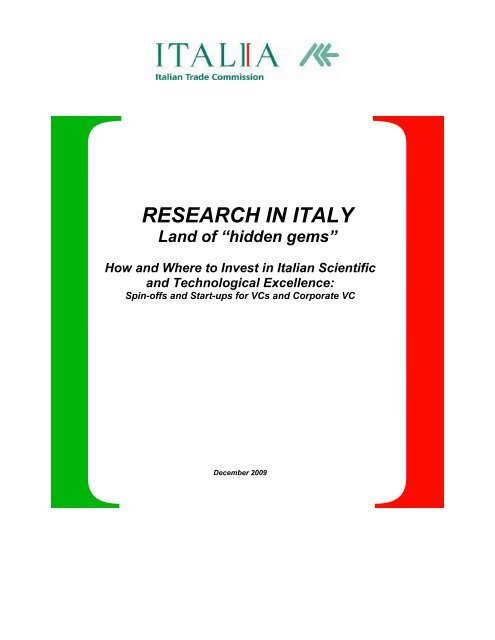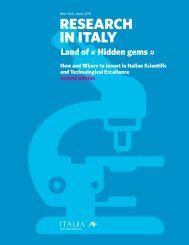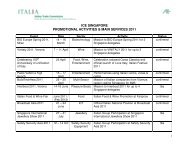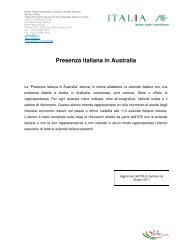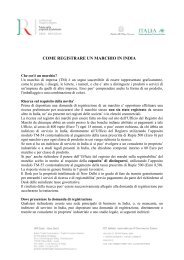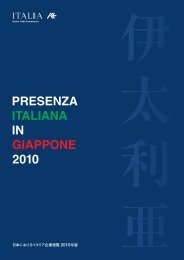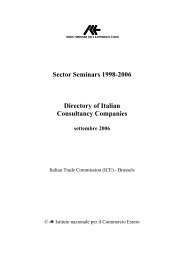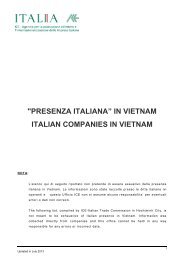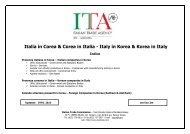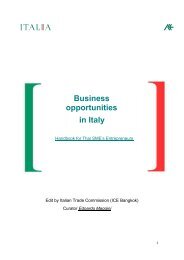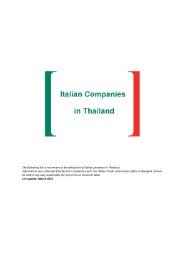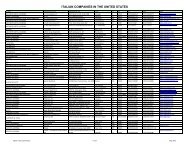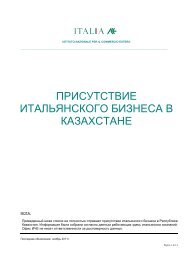RESEARCH IN ITALY - Ice
RESEARCH IN ITALY - Ice
RESEARCH IN ITALY - Ice
Create successful ePaper yourself
Turn your PDF publications into a flip-book with our unique Google optimized e-Paper software.
<strong>RESEARCH</strong> <strong>IN</strong> <strong>ITALY</strong>Land of “hidden gems”How and Where to Invest in Italian Scientificand Technological Excellence:Spin-offs and Start-ups for VCs and Corporate VCDecember 2009
<strong>IN</strong>DEXEXECUTIVE SUMMARY .......................................................................................................................... 31. <strong>RESEARCH</strong> AND DEVELOPMENT <strong>IN</strong> <strong>ITALY</strong>: AN OVERVIEW ...................................................... 51.1. Evolution of Italian investment in R&D: public and private sectors expenditures............................ 51.2. Private equity and venture capital investments.............................................................................. 61.3. Research results: publications, patents and Technology Balance of Payments............................. 72. TECHNOLOGY PARKS & <strong>RESEARCH</strong> <strong>IN</strong>FRASTRUCTURES ....................................................... 92.1 Research Institutes and Universities ............................................................................................. 92.2 Technology Parks ....................................................................................................................... 112.3 Private research institutes ........................................................................................................... 142.4 The technological meta-districts .................................................................................................. 163. SP<strong>IN</strong>-OFFS AND START-UPS <strong>IN</strong> <strong>ITALY</strong> ....................................................................................... 174. VENTURE CAPITAL ...................................................................................................................... 215. BANK<strong>IN</strong>G FOUNDATIONS AND ASSOCIATIONS THAT SUPPORT <strong>IN</strong>VESTMENTS ................. 236. GOVERNMENT STRATEGIES, POLICIES, PROGRAMS & <strong>IN</strong>VESTMENT .................................. 266.1 Introduction ................................................................................................................................. 266.2 Action lines.................................................................................................................................. 266.3 National support measures recently implemented ....................................................................... 276.4 Regional support measures......................................................................................................... 296.5 European measures.................................................................................................................... 297. <strong>IN</strong>TELLECTUAL PROPERTY......................................................................................................... 318. SUCCESS STORIES <strong>ITALY</strong>-USA .................................................................................................. 329. EVENTS ......................................................................................................................................... 3510. ADDITIONAL L<strong>IN</strong>KS ........................................................................................................................ 37Index of FiguresFigure 1: Investments distribution in high tech companies ........................................................................ 6Figure 2 :Regional Distribution of Patents filed at the EPO ....................................................................... 8Figure 3. Map of the Italian Technology Parks ........................................................................................ 12Index of TablesTable 1: Italian University Ranking............................................................................................................ 9Table 2: National Research Council Description ..................................................................................... 11Table 3: List of Technology Parks in Italy................................................................................................ 14Table 4: List of the Main Meta Districts in Italy ........................................................................................ 16Table 5: Selection of 15 among the Most Established Italian Spin-offs ................................................... 19Table 6: Selection of Innovative Italian Start-ups .................................................................................... 20Table 7: Selection of Venture Capital Firms in Italy................................................................................. 22Table 8: Italian Foundations.................................................................................................................... 24Table 9: Selection of Italian Associations that Support Innovation .......................................................... 25Table 10: New Support Measures for Innovation .................................................................................... 29Italian Trade Commission - New York20092
Executive SummaryIt is becoming increasingly clear that the responsible factors for the economic success, growth andcompetitiveness of a nation in the international panorama are numerous. It is also widely accepted that akey driver for a nation’s long-term growth is the ability of universities, research centers and privatecompanies to generate innovation through knowledge and research inputs.In the last few years, Italy has made huge strides towards improving the R&D sector with the ultimategoal to increase the country system’s competitiveness worldwide. Although there is still considerableroom for improvements and the Italian innovation performance remains below the EU average, the highquality of research occurring in the Italian infrastructures as well as the strength of Italy’s scientificcommunity and the gradual but constant increase in the number of patents are interesting featuresthat emerge by the most accredited reports on innovation 1 .The present report aims to draw a clear picture of the Italian R&D landscape,providing VCs and Corporate VCs with tangible opportunities of investing in spinoffsand start-ups originated from Italian Universities and Research Centers.The report will provide a broad spectrum of information on the following topics:o...... An overview of the Italian R&D system: innovation performance indicators will guide the investorsthrough some of the most significant innovation indexes such as scientific publications, patenttrends and technology balance of payments (TBP). These parameters are respectively considerednecessary measurement for: the quality and the scientific relevance of new findings, the inventiveactivity and the technological competitiveness of an economic system within the internationalpanorama.o...... Italian main innovation and research “incubators”: technology parks, research centers anduniversities. They host researchers and therefore ideas, functioning as innovation accelerators andfostering the formation of spin offs and start-ups. In this section, a special attention will be given toTechnology Parks and Business Incubators, able to create a dynamic interaction amongcompanies, research, finance and the authorities, thus contributing to the creation of a growthoriented business environment.o...... Spin offs and Start ups: a growing number of spin offs and start ups are being created in Italy as asign that entrepreneurship among scientists and researchers is increasing. In the last few yearsmore than 700 start ups were created. This report provides VCs and investors willing to explore this“hidden treasure” with a list of 25 among the most innovative Italian companies.o...... A selected list of venture capitalists in Italy: although the country is still experiencing asignificant lack of VC activity and the industry is rather immature compared to several Europeanneighbors, however, there are several active VC funds, both private and public or a combination ofthe two. The listed VCs could support prospective foreign players by co-investing in early stagecompanies.o...... Examples of additional sources of funding: banking foundations, a traditional source of fundingfor education and science in Italy, have started to actively support the high-tech industry through1 Scientific publication data (1998-2008) are derived from: Essential Science Indicators, Thomson Reuters, 2008Patents information are derived from : Main Science and Technology Indicators 2008/2, OECD, 2008Italian Trade Commission - New York20093
several initiatives and a list of associations that work to foster economic development throughinnovation is also herewith provided.o...... A section focusing on Italian Government Strategies, Policies and Investment: Italianinstitutions, both at regional and national level, are increasingly becoming aware of the importanceof supporting innovation and research. Fiscal incentives and programs such as <strong>IN</strong>DUISTRIA 2015are among the numerous possibilities of co-financing. Here, we try to give a comprehensive pictureon the available and most interesting funding programs for a foreign company-entity willing to investand co-invest in Italy in R&D activities.o...... Information on the current government regime concerning Intellectual Property rights: as afounder member of the European Union, Italy is at the forefront of European IP Rightsdevelopments and has some of the most modern and up-to-date IP practices in the world.o...... A brief list of success stories: a selection of the most recent and relevant examples of alliances,collaboration agreements and investments between Italian companies or Universities and Americancounterparts.o...... A list of upcoming events of interest for R&D companies, start ups and spin offs: this piece ofinformation represents a useful instrument in highlighting the most important opportunities to meetItalian researchers and entrepreneurs, as well as current investors.Italian Trade Commission - New York20094
1. Research and Development in Italy: an OverviewScience and technology innovation indicators are widely used instruments employed to explore theprogress of national innovation strategies and recent developments of a country in a rigorous and easilyreadable way. Although according to the European Innovation Scoreboard, Italy positions itself in thegroup of “Moderate Innovators” and the country is still facing major challenges in order to catch up withthe OECD leaders, since 2006, Italy manifested important signs of positive growth in R&D sectors.By analyzing key indicators, such as, Italian R&D expenditures, investments, TBP and research results,publications and patents, the present section of this report will highlight the measurable and importantprogresses Italy has made toward the difficult path of becoming a leader in innovation. The followingsections will then focus on the tangible results of this improvement, giving a thorough description of theItalian R&D excellence.1.1. Evolution of Italian investment in R&D: public and private sectors expenditures 2In the past years, Italy registered a gradual but important increase in R&D expenditure 3 , confirming thestrong commitment the country is undertaking in order to align Italy with other European leaders. In fact,from 2003 to 2006, the cumulative R&D investments - performed by private companies, publicadministration entities, non for profit private institutions and universities all together - increased from€ 14.769 Million to € 16.835 Million: a growth in real terms that equals to 3.99%. These numbers suggestthat the Italian progress is only second to that registered by Germany and Spain, which in the last yearshas registered a very pronounced expansion of its R&D investments.In 2006, the most significant contribution to the total expenditures in R&D activities comes from theprivate sector with a quota of 48.8% over the total national amount spent; followed by universities with30.3%; public institutions with 17.2% and non for profit private institutions with 3.6%. The last availabledata - referred to year 2006 - indicate a positive trend in the growth of R&D expenditures when comparedto the previous year’s statistics in the all the above mentioned sectors: the private sector spent in fact4.5% more in R&D compared to the previous year; universities registered an increase of 8.2%, publicinstitutions an increase of 7.3% and non for profit private institutions a 90.9% increase.It is important to highlight that investments in Italy are unevenly distributed. The Piemonte region ranksfirst for the highest R&D expenditure over GDP 4 (with a ratio of 1.8%), followed by the Lazio region(1.71%), Liguria (1.29%) and Emilia Romagna (1.23%) while for Calabria and Val D’Aosta regions thisratio is below 0.5%. Interestingly, the summary of the R&D expenditures of the Northern Italian regions,together with the one of Toscana, Emilia Romagna and Lazio regions account for 75% of the all nationalexpenditures. This investments polarization emphasizes the strong differences that exist in the Italianinnovation system between northern-central and southern regions; it also highlights the autonomous roleplayed by each region in embracing and developing specific innovation measures.In 2006, Italy invested 1.15% of its GDP in R&D activities. Although this percentage is still below theindustrialized nation’s average, it is important to notice that this growth correspond to a 9.9% increase inthe six years 2000-2006. 52Some of the data reported in this paragraph were derived from the Annual Report on Innovation 2009, COTEC3 ISTAT: Italian National Statistics Institute4 The R&D expenditure over GDP ratio represents the size of investment in science over the wealth generated by a country5 Main Science and Technology Indicators 2008/2, OECD (2008). Table A.5 AppendixItalian Trade Commission - New York20095
1.2. Private equity and venture capital investmentsItaly is still experiencing a significant lack of venture capital activity and the industry is rather immaturecompared to the other European countries. However, venture capital in Italy is starting to grow.OECD estimates of 2007 showed that available venture capital funds in Italy were equivalent to 0.031%of GDP. The percentage has improved in the last year since in 2008 OECD estimates have recorded avalue of 0.067% of GDP 6 . The OECD Science Technology & Industry Scoreboard of 2007 ranked Italy inthe 17 th position in terms of availability of venture capital funds as a percentage of the GDP and in 2008,there has been an improvement from the 17 th to the 12 th position.Although the size of the market in absolute value is rather small, the years 2006, 2007 and 2008 haveregistered the highest values over the past five years. According to the Italian Private Equity and VentureCapital Association (AIFI)’s statistics 7 , the effects of the international financial crisis have reached theItalian private equity and venture capital market that, after hitting record levels in 2008, the first half of2009 saw a decrease in activity. Between January and June 2009, the market recorded 155 new deals,for a total value of 1.069 million Euros. The decrease in the number of deals was significant but limitedto 9%.Specifically, AIFI reports that in the first semester 2009, 27% of the total amount invested went totransactions in the high technologysector. It is interesting to observethat compared to the previousyears the number of investmentsin the high tech sector significantlyincreased while the amountinvested registered only a slightincrease. This data suggest thatthere is the lack of so-called megadeals (over 300 million euros) inthe first half the year.Figure 1: Investments distribution inhigh tech companies6 Sources: OECD Science Technology and Industry Scoreboard 2007 & 2008, in Rapporto Innovazione di Sistema 2007 & 2008. FondazioneRosselli and Corriere della Sera7 AIFI statistics: The Italian Private Equity and Venture Capital market in the first semester 2009Italian Trade Commission - New York20096
1.3. Research results: publications, patents and Technology Balance of PaymentsScientific PublicationThe analysis of a nation’s research production allows to clearly evaluate not only the ability to generatenew scientific findings - in other words, to evaluate how brilliant scientists are - but it also gives morecomplex information such as the overall level of innovation of research labs, universities, and researchcentres, in which the research is performed.It is in fact well known that in order to translate great ideas into great scientific results and ultimately intogreat applications, scientists need to have the right support and environment - in terms of equipment,funding, human resources etc. - to finalize their research. It is therefore important to understand how Italyperforms when compared to other countries.With reference to the years 1998-2008, Italy ranks 8 th in the global classification of scientific publication,with a total number of articles close to 400,000 8 . This number is significantly higher compared to theSpanish scientific production (below 300,000 publications) and it is not far from Canada (414,000) andFrance (548,000). Other European countries such as the UK and Germany reach higher levels in thenumber of publications produced. As expected, the US leads the ranking with over 3 Million publications.Another important criteria to be taken into consideration when evaluating scientific publications, is thenumber of citations an article receives. This index correlates with quality, novelty, and scientificrelevance. The US ranks 1 st for number of citations (over 42 million), while Italy positions itself in 7 thplace, after France and Canada.These results indicate how Italy represents one the most relevant contributors to the worldwidescientific production.PatentsAmong the most interesting indicators related to innovation, patents deserve a special attention sincethey reflect not only the creativity of a nation but also its entrepreneurial mindset. The last statisticsavailable - referred to the time period, 2001-2006 - suggest that for Italy, the number of triadic patentsfiled 9 increased by 21% - the data are normalized on 1 million inhabitants. Also, a comparison betweenthe three-year periods, 1992-1994 and 2002-2004, shows a dramatic increase of 53% in the number ofpatents Italy has filed in collaboration with international partners. This index is particularly importantbecause it gives an indication of how much a country is open to international collaboration.It is important to underline that, as already reported for R&D expenditures, the number of patents filed atthe EPO dramatically varies among Italian regions 10 . As shown in Fig.2, in 2006, Emilia Romagna leadswith 170 patents per million of inhabitants, followed by Friuli Venezia Giulia (132.3), Lombardia (132),Veneto (117), Piemonte (102.3) and Toscana (66). Italian southern regions such as, Molise, Sardegna,Basilicata and Calabria, each filed less than 10 patents per million inhabitants.Together, all the analyzed results indicate a positive trend of growth for the country and this is particularlytrue for certain Italian regions in which an outstanding research population, the proximity of gooduniversities and creative companies are coming together to form smart clusters that are indeed servingas innovation forges.8 Essential Science Indicators, Thomson Reuters, 20089 Patents filed at the three larger patent offices: the European Patent Office (EPO), the United States Patent and Trademark Office (USPTO) andthe Japan Patent Office (JPO)10 StatExtract, Patents by region database, OCSE 2008Italian Trade Commission - New York20097
Figure 2 :Regional Distribution of Patents filed at the EPO(data are normalized on 1 million inhabitants)Technology Balance of PaymentsThe technological balance of payments measures international transfers of technology, such as: patents;inventions; license fees; purchases and royalties paid; trademarks; know-how; patterns and designs; andservices with technological content, like technical assistance, engineering, training of personnel, R&Dservices and technology exchange. Unlike R&D expenditure, these are payments for production-readytechnologies.The outbound flow indicates a certain country’s ability to commercialize its technological competencesand know-how in the international market, while the inbound flow indicates the ability to use and integrateforeign technologies in its system. In the last years, Italy showed an increase in both the inboundand outbound flows and the balance has a positive value in Italy, likewise in almost all Europeancountries.Italian Trade Commission - New York20098
2. Technology Parks & Research InfrastructuresAs outlined in the executive summary, in Italy, research is conducted through a network of ScienceParks, Business Incubators, several Private Research Institutes and Public ResearchOrganizations (PRO). These “entities/organizations” can work autonomously or come together todevelop research and business ideas within public-private consortia.2.1 Research Institutes and UniversitiesIn Italy the Ministry for Education University and Research (MiUR) coordinates national and internationalscientific activities, allocates funding to universities and research centers, and establishes the guidelinesfor the support of public and private research and technological development funding. Furthermore, MiURcoordinates the preparation of the triennial National Research Programme (NRP), the main governmentaldocument for R&D planning that sets the strategic lines for the national system.Universities - Research activity in Italy is mainly carried out by universities- in 2006 universitiesspent 30.3% of total R&D national expenditure as discussed in the previous paragraph. There are 95universities in Italy, the majority of which – over 70% - is public (67 State universities) 11 ; however,Public Research Organizations (PROs) play an extremely important role in the Italian researchpanorama. Italian Universities - public and private - have been ranked by one of the most influentialeconomic newspapers in Italy 12 taking into consideration 10 main criteria: number of highly talentedprofiles; ability to attract students; number of students that are able to graduate; inactivity; number ofstudents that are able to graduate within the minimum time; ratio between students and availableresources; ratio research/ personnel; research/funding; research/ external funding; employment ratepost graduation. In Table 1, the top 10 Public Universities and the top 5 Private Universities thatscored better in Italy are listed.1. Politecnico di MilanoItalian University RankingPublic Universities2. Università degli Studi di Modena e Reggio Emilia3. Università degli Studi di Trieste4. Politecnico di Torino5. Università di Pavia6. Università degli Studi di Ferrara7. Università degli Studi di Trento8. Università degli Studi del Piemonte Orientale9. Università degli Studi di Padova10. Università Politecnica delle MarchePrivate Universities1. Università Commerciale Luigi Bocconi- Milano2. Università San Raffaele- Milano3. Libera Università Internazionale degli Studi Sociali (LUISS)- Roma4. Università Cattolica del Sacro Cuore (Milano)5. Università Carlo Cattaneo (LIUC) (Castellanza –Varese)Table 1: Italian University Ranking11Web Portal “Italian Research”: http://www.ricercaitaliana.it/universita_chifaricerca.htm9Italian Trade Commission - New York2009
Public Research Organizations: Italian PROs are numerous and internationally recognized for theircommitment in the advancement of science, research and technology. In the national panorama incollaboration with the universities, they play a key role in fostering innovation. For brevity, we only listsome of the most significant organizations, while the National Research Countil (CNR) being one ofthe most relevant for the purpose of the present report, will be extensively described in Table 2. 13- The National Research Council (CNR), the main national research organization working in allscientific disciplines, which acts both as research performer and financial supporter.- The National Agency for New Technologies, Energy and Environment (ENEA), operating in thefields of energy, environment and new technologies to support national competitiveness andsustainable development.- The National Institute for Nuclear Physics (<strong>IN</strong>FN) dedicated to the study of the fundamentalconstituents of matter and conducting theoretical and experimental research in the fields ofsubnuclear, nuclear, and astroparticle physics. It manages large scale equipments andparticipates in CERN activities- The Italian Space Agency (ASI) in charge of coordinating all national efforts and investments inthe space sector.THE NATIONAL <strong>RESEARCH</strong> COUNCIL (CNR)The Italian National research Council (CNR) is the largest public research institution in Italy. CNR’sMission is to:• Perform research in its own Institutes;• Promote innovation, national industrial system’s competitiveness, and national research systeminternationalization;• Provide technologies and solutions to emerging public and private needs;• Advice Government and other public bodies;• Insure the best training to the human force the institution employsCNR Organization: CNR integrates its activities through an interdisciplinary structure of 11 NationalDepartments. The 108 Institutes, coordinated by the Departments, are located throughout Italy and theyfunction grouping together technical and scientific areas of expertise.CNR employs more than 8,000 people, of whom more than half are researchers and technologists.From a financial point ofview, the main resourcescome from the Government -552 Million € of InstitutionalFunds in 2007. Theremaining part - 309 Million€- is derived from the market:as much as 30% of CNR’srevenues come from externalservices - e.g. technologicalCNR Technology Transfer: in order to encourage innovation andstimulate the competitiveness of businesses through market orientedTechnology Transfer activities; disseminate know-how and finalizepartnership agreements with external parties to foster cooperation,CNR has created an agile Tech Transfer machinery structured asfollows:- A central Business Development Unit that evaluates and theimplements new spin-off enterprises;- Rete Ventures, a Technology Transfer enterprise, 90% - ownedby CNR, whose task is to provide the scientific network with12 Italian Universities Ranking -Published in “Il Sole 24 Ore”, July 24 th , 200913The present data are derived from a Publication by Ufficio Pubblicazioni e Informazioni Scientifiche – CNRItalian Trade Commission - New York200910
due diligence; privateagreements; externalcontracts with governmentalinternational organizations,etc.CNR’s financial strategyidentifies the following 3 mainfunded activities:1. curiosity drivenresearch (allocated funds:15%);2. development of newresearch capabilities(allocated funds: 15%);3. R&D activitiesperformed in cooperationwith universities, otherresearch institutions andindustrial companies(allocated funds: 70%).Table 2: National Research Council Descriptionprofessional services and entrepreneurial skills to protect, valorize andcommercialize new technologies;- Quantica SGR, an Asset Management Company, whose aim is toinvest in high-tech spin offs and to promote the development ofventure capital.The activities performed by the “Technology Transfer Unit” include theset up of spin-offs (42 operating in 2009) and the protection andenhancement of CNR scientific results (340 Patents in the entire CNRintellectual property right portfolio).Furthermore:- As of 31 Dec. 2008, CNR participated in 93 joint ventures, bothItalian and foreign. The joint ventures cover the entire spectrum oflegal structures: companies, consortia, associations, foundations,and European Economic Interest Groupings;- CNR partners with large hi-tech companies; governmentdepartments and local authorities; associations designed toenhance the competitiveness of the manufacturing system;dissemination and know-how transfer specialized entities.2.2 Technology ParksTechnology parks bring together companies, venture capitalists, universities, laboratories and researchcenters, increasing the wealthof the local communities byfostering the culture ofinnovation and thecompetitiveness of privatecompanies, creating a fertileand collaborative workingenvironment and offering awide range of services. Thefirst science park was set up inTrieste in 1982; in the 1990’s anational program extended thecreation of technology parks tothe whole nation, favoring theless developed areas. According toRIDITT 14 , 44 Science andTechnology Parks operate inItaly, most of which are shownin Figure 3. 1514 RIDITT: Italian Network for Innovation and Technology Transfer to SMEs- http://www.riditt.it15 Adapted from APSTI website: http://www.apsti.itItalian Trade Commission - New York200911
Figure 3. Map of the Italian Technology ParksBelow a list of technology parks in Italy 16NAMEArea Science ParkLOCATIONTriesteNUMBER OFPRIVATECOMPANIES/ORGANIZATIONS90AREA OF <strong>IN</strong>TERESTENVIRONMENT; ENERGY; PHYSICS; ICT;NANOTECHNOLOGY; BIOLOGICAL SCIENCES;SERVICES; TELECOMUNICATIONSBio Industry Parkdel Canavese Torino 40Centuria- RIT Cesena - ER 70Citta’ della Scienza Napoli 22ComoNExTConsorzio PST/KRComoCrotone39 publicorganizationsEnvironment Park Torino 70Friuli Innovazione Udine 25Kilometro Rosso Bergamo 20Molise Innovazione Campobasso 35PALMER Frosinone ConsortiumBIOTECH; DIAGNOSTICS; PHARMACEUTICAL;TECHNOLOGY TRANSFERAGRO-FOOD; <strong>IN</strong>NOVATIVE MATERIAL; MECHANICTECHNOLOGY TRANSFERENVIRONMENT; CULTURAL HERITAGE;COMUNICATIONSENERGY; ICT; MECHANICS; NANOTECHNOLOGY;R&D; BIOLOGICAL SCIENCES; SERVICES;TECHNOLOGY TRANSFERENVIRONMENT; ENERGY; TECHNOLOGY TRANSFERAGRO-FOOD; TECHNOLOGY TRANSFER; CULTURALHERITAGE; ENERGY;ENVIRONMENT; BIO-ARCHIRECTURE; ENERGY;NANOTECHNOLOGY; R&D; TECHNOLOGY TRANSFERENVIRONMENT; BIOTECH; ENERGY; ICT;<strong>IN</strong>NOVATIVE MATERIALS; METALLURGICAEREOSPACE; AGRO-FOOD; ENVIRONMENT;BIOARCHITECTURE; BIOTECH; BIOMEDICAL;COMUNICATIONS; <strong>IN</strong>DUSTRIAL DESIGN;DIAGNOSTICS; CONSTRUCTION; ELETTRONICS-MICROELETTRONICS; ENERGY;PHARMACEUTICALS;ICT; MANAGEMENT; MANIFACTUR<strong>IN</strong>G; <strong>IN</strong>NOVATIVEMATERIALS; MECHANICS; NANOTECHNOLOGY; BIO-SCIENCES; TELECOMUNICATIONS;TRANSPORTATIONTECHNOLOGY TRANSFERAGRO-FOOD; ENVIRONMENT; ENERGY;R&D; BIO-SCIENCES; TECHNOLOGY TRANSFERAGRO-FOOD; ENVIRONMENT; ELECTRONICS-MICROELECTRONICS; ENERGY; ICT; <strong>IN</strong>NOVATIVEMATERIALS; TECHNOLOGY TRANSFERParco ScientificoRomanoRomaNotAvailableENVIRONMENT; AGRO-FOOD; BIOMEDICAL;ENERGY;ICT; MECHANICSParco TecnologicoPadanoLodi 12AGRO-FOOD; ENVIRONMENT; BIOTECH;DIAGNOSTICS;16Data derived and elaborated from APSTI website: http://www.apsti.itItalian Trade Commission - New York200912
PHARMACEUTICALS; R&D; BIO-SCIENCES;SERVICES;TECHNOLOGY TRANSFERParma Tecninnova Parma Not AvailableAGRO-FOOD; ELECTRONICS - MICROELECTRONICS<strong>IN</strong>NOVATIVE MATERIALS; TECHNOLOGY TRANSFERPolo TecnologicoNavacchio Pisa 14ENVIRONMENT; ENERGY; ICT; TECHNOLOGYTRANSFERPolo TecnologicoMI-Bicocca Milano Not Available TECHNOLOGY TRANSFERPont-Tech Pontedera 22PST della Sicilia Palermo 25PST Galileo Padova Not AvailablePST Tecnomarche Ascoli Piceno 65Sardegna Ricerche Cagliari 48ENVIRONMENT; BIOMEDICAL; <strong>IN</strong>DUSTRIAL DESIGN;ENERGY; MECHANICS; R&D; TECHNOLOGYTRANSFERAGRO-FOOD; ENVIRONMENT; CULTURAL HERITAGE;BIOTECH; DIAGNOSTICS; ENERGY; ICT; <strong>IN</strong>NOVATIVEMATERIALS; NANOTECHNOLOGY; R&D; SERVICES;TECHNOLOGY TRANSFERBIOMEDICAL; <strong>IN</strong>DUSTRIAL DESIGN;<strong>IN</strong>NOVATIVE MATERIALS; TECNOLOGY TRANSFERAGRO-FOOD; ENERGY; ICT;TECNOLOGY TRANSFERBIOTEC; BIOMEDICAL; ICT; TECHNOLOGYTRANSFERScience Park RAFServitec SrlMilanoBergamoResearch centers and2 start-ups23 companies and 6organizationsBIOTECH; BIOMEDICAL; TECHNOLOGY TRANSFERAGRO-FOOD; ENVIRONMENT; CULTURAL HERITAGE;BIO-ARCHITECTURE; BIOTECH; BIOMEDICAL;DIAGNOSTICS; CONSTRUCTIONS; ELECTRONICS –MICROELECTRONICS; ENERGY; ICT;MANIFACTUR<strong>IN</strong>G; <strong>IN</strong>NOVATIVE MATERIALS;METALLURGIC; NANOTECHNOLOGY; SERVICES;TRANSPOTATIONSTECHNOLOGY TRANSFERSTAR-ParcoScientifico diVeronaVeronaNot AvailableTech Napoli Napoli Not AvailableTecnopolis Bari 26AGRO-FOOD; ELECTRONICS-MICRO-ELECTRONICS;ICT; TECHNOLOGY TRANSFERAEROSPACE; CULTURAL HERITAGE; BIOTECH;<strong>IN</strong>NOVATIVE MATERIAL; TRANSPORTATION;TECHNOLOGY TRANSFER;ICT; TELECOMUNICATIONS; TECHNOLOGYTRANSFERTecnopolo SpaToscana LifeSciences ParkRomaTecnopolo Tiburtino:60Parco di CastelRomanoSiena 17AEREOSPACE; ENVIRONMENT; BIOTECH;ELECTRONICS – MICROELECTRONICS; ICT;TECHNOLOGY TRANSFERBIOTECH; BIOMEDICAL; DIAGNOSTICS;PHARMACEUTICAL; R&D; BIOSCIENCES;TECHNOLOGY TRANSFERUmbria Innovazione Terni Not Available TECHNOLOGY TRANSFERItalian Trade Commission - New York200913
Vega PST diVeneziaMargheraVenezia200AEREOSPACE; ENVIRONMENT; CULTURALHERITAGE BIOTECH; COMUNICATIONS; ENERGY;ICT;<strong>IN</strong>NOVATIVE MATERIALS; NANOTECHNOLOGY; R&D;BIO-SCIENCES; SERVICES; TELECOMUNICATIONS;TECNOLOGY TRANSFER;Veneto InnovazioneMargheraVeneziaNot AvailableICT; TECHNOLOGY TRANSFERTable 3: List of Technology Parks in Italy2.3 Private research institutesPrivate research organizations play a major role in research and innovation in Italy. Some of the mostimportant industrial research centers are:- ENI Tecnologie: Eni is an integrated energy company, committed to developing its activities inresearch, production, transport, transformation and marketing of oil and natural gas. Eni is activein 70 countries with a staff of about 79,000 employees.- Centro Ricerche Fiat: C.R.F. was established in 1978 as the Group’s centre of expertise ininnovation, research and development. Now an internationally recognized centre of excellence,C.R.F.’s work constitutes a strategic lever for the Group’s businesses, enhancing performancethrough development and transfer of innovative content which makes the Group’s products bothcompetitive and distinctive. With over 850 employees, C.R.F. draws on a broad array of technicalskills, in addition to a series of cutting-edge laboratories for powertrain systems testing,electromagnetic compatibility investigations, NVH analyses, driving simulations, materials andprocess development, optoelectronics and microtechnologies. C.R.F. achieved significant resultsfor the year, as demonstrated by the 51 new patent applications it filed in 2008, bringing the totalnumber of patents it holds to over 2,300. A further 600 patents are currently pending. C.R.F. hasalso developed a global network of more than 150 universities and research centres and 1,000industrial partners around the world.- Telecom Italia Lab: TIL is the company of Telecom Italia Group for scouting, evaluating,developing and managing innovative business opportunities. To achieve these goals, thecompany focuses on R&D, corporate venture capital, incubation and the development ICT skills.The corporate venture capital and incubation activities address all phases of the development ofnew companies: by making investments and offering business and technological consulting wecreate industrial synergies both with our internal R&D and with Telecom Italia Group businesses.- Centro Sviluppo Materiali: CSM is a private research company founded in 1963 at the initiativeof the most important Italian steel making and mechanical industries. CSM main assets are inresearch and development applied to metals (steel, aluminum, titanium, special alloys and metalmatrix composites), ceramics and coated products.Among the most prestigious private science institutions:- Mario Negri Institute: is a not-for-profit biomedical research organization. It was founded in1961, and started work in Milan on 1 February 1963. There are now research units in Bergamo, atRanica – near Bergamo – and at Santa Maria Imbaro, near Chieti. The Institute’s main aim is tohelp defend human health and life.14Italian Trade Commission - New York2009
- San Raffaele Institute: is a private Scientific Institute, belonging to the San Raffaele del MonteTabor Foundation, recognised by the Italian Ministry of Health as a Scientific Institute carrying outbiomedical research and clinical activities of relevant national interest (IRCCS). San RaffaeleInstitute is relentlessly pursuing its three interrelated lines of clinics, research and education since1971 when it was established.- The Italian Institute of Technology: (IIT) is a foundation established jointly by the Italian Ministryof Education, Universities and Research and the Ministry of Economy and Finance to promoteexcellence in basic and applied research and to contribute to the economic development of Italy.The primary goals of the IIT are the creation and dissemination of scientific knowledge as well asthe strengthening of Italy's technological competitiveness. To achieve these two goals, the IIT willcooperate with both academic institutions and private organizations, fostering through thesepartnerships scientific development, technological advances and training in high technology.Italian Trade Commission - New York200915
2.4 The technological meta-districtsTechnological meta-districts are initiatives aimed at reproducing the positive results derived by industrialdistricts. They focus on high technological services and products and are promoted at the central andregional levels.META-DISTRICTS <strong>IN</strong> <strong>ITALY</strong>Torino Wireless(North-western Italy)Veneto Nanotech(North-eastern Italy)Biotech in Lombardia(Northern Italy)Hi mechEmilia Romagna(Central-northern Italy)Aerospace TechnologyDistrict (Central Italy)IMAST in Campania(Southern Italy)Etna ValleyA foundation financed with public and private funds which groups some of the keyplayers in the geographical area of Turin operating in the field of advancedtelecommunications technology such as the Mario Boella Institute, T-Lab(Telecom Italia), Alenia, Motorola and CRF (Fiat).A district financed by national and regional funds aimed at creating an area ofexcellence on nanotechnology in Veneto. The district includes private companiesand local scientific institutions.An initiative aimed at facilitating the development of a biotech district in an keyarea where this industry in Italy is already growingA district for mechatronics, which brings together 130 private companiesoperating in the region (including Ferrari and Lamborghini) along with the mostimportant local university departments and research bodies working on thissubject.A pole for the development of a high tech productive system in cooperationwith some of the major Italian players in the sector, such as Centro SviluppoMateriali, Alenia, Avio and ASI (Italian Space Agency).A district on the engineering of polymeric and compound materials, with thedirect involvement of national and regional institutions, universities and researchcenters such as CIRA (Italian Aerospace Research Centre), Elasis (Fiat), Cetena(research for naval ship building) and companies such as Fincantieri and Esaote.An initiative for the promotion of the high tech cluster in the area of Catania(Sicily Region) around ST Microelectronics, Nokia, Marconi Mobile.Table 4: List of the Main Meta Districts in ItalyItalian Trade Commission - New York200916
3. Spin-offs and Start-ups in ItalyAs documented by the most important R&D innovation reports, in Italy, all main universities and researchcenters are now spinning out a growing number of innovative companies. These companies representthe hidden gems that can become a great business opportunity for VCs and/or Business Angels willing tosupport them. Although the phenomenon is still not comparable to the one experienced in the US in thelast fifty years, however, the scientific talent and the enthusiasm shown by these young researchers ispalpable.Among the organizations monitoring this phenomenon, one of the most active is NETVAL - the ItalianNetwork for the Valorization of the University Research- the association of Italian public universitieswhose goal is to enhance the value of its members’ research activities by working with tech-transferoffices and developing collaborations with the private sector. NETVAL’s platform include all Italian mostimportant Universities and, thanks to this large network, the association is able to draw a picture andmonitor universities’ productivity in terms of spin offs and patents produced.According to NETVAL’s report 17 , since 2000, Italy continues to display signs of a strong acceleration inthe number of new born spin-offs. The report highlights that among the 710 spin-offs currently operatingin Italy, more than 85% were born in the last 8 years and over 80% are located in the northern-centralItalian regions, co-localized with the most active Italian universities. Among the most represented sectorsare: ICT (35.8%), life sciences (15.5%), energy and environment (14.6%), electronics (11%) andbiomedical (7.4%).In order to facilitate the transition from bench to market and with the aim of providing brilliant academicscientists with the necessary instruments to best use their innovative ideas and translate them incommercial technologies, 90.7% of the Italian universities are now flanked by a Technology TransferOffice (TTO). TTOs’ most relevant objective is to accelerate the creation of entrepreneurial initiative,offering the necessary assistance and valuable instruments to spin-offs.NETVAL’s website provides a directory of Italian spin-offs organized by university. The online list isyet to be completed. However, customized selection of university spin-offs by sector can be requested bycontacting the Italian Trade Commission in New York (newyork@ice.it) - or segreteria@netval.it.In order to provide the reader with a selection of some of the most interesting and establishedItalian spin-offs that might be of interest for VCs and/or a corporate VCs, the authors of the presentreport used a screening methodology able to guarantee objective and homogeneous selection criteria. Alogic assumption is to think that the most established and successful spin-offs are the direct result of afruitful, cooperative and challenging scientific environment. With this theory in mind, it was decided to usethe top 10 Italian Universities listed in Table 1 - page 9 - as the source from which the most promisingspin-offs could be derived.When analyzing for instance the 15 spin-offs born by Politecnico di Milano, the 2 spin-offs described inTable 5 were selected by using the following criteria: year of establishment and information availability. Itis in fact well known that the first three years of establishment are, for newly born companies, the mostdifficult and challenging; therefore in order to properly evaluate a company’s success, it was necessary tolook at companies that were able to overcome this critical threshold.The 10 Italian Universities listed in Table 1 were analyzed by using the above described criteria with theexception of Politecnico di Torino and Università di Pavia, which in Table 1 ranked respectively 4 th and5 th , given the absence in the NETVAL website of information regarding their spin-offs.17 Sixth NETVAL Report, Jan. 2009 “ Patents and Private companies: the universities’ contributions”Italian Trade Commission - New York200917
15 ITALIAN SP<strong>IN</strong>-OFFS: A SELECTION(complete list can be found on www.netval.it)CompanyNameEstablishedinSpin-off ofCompany DescriptionAresys S.r.l. 2003 Politecnico di MilanoAresys SRL offers ad-hoc innovative solutions to spaceborne,air-borne and ground based remote-sensingproblems, exploiting state-of-the-art technologies and thelatest academic research achievements in the field.T.R.E. S.r.l. 2000 Politecnico di MIlanoTRE – the first spin-off company of the Politecnico di Milano -has developed and patented the PSInSAR technique, aunique tool that detects, measures and monitors differentgeophysical phenomena (e.g. subsidence, uplift, landslides,seismic faults, etc.) and verifies the stability of individualstructures, providing precise measurements of displacements.Embit S.r.l. 2004Università degli Studi diModena e ReggioEmiliaEmbit develops ad hoc embedded and wireless solutions.TydockpharmaS.r.l.2004Università degli Studi diModena e ReggioEmiliaTydockpharma is a chemistry-driven research-intensivecompany discovering new drugs targeting major infectiondiseases. Research products are mainly hit, lead and drugcandidate with anti-infective activities based on an innovativemechanism of action that involves an unexplored biologicaltarget (ThyX).ES.TEC.O.S.r.l.1999Università degli Studi diTriesteES.TE.CO develops multi-objective optimization and designenvironment software.CREST S.r.l. 2004Università degli Studi diTriesteCREST aims to deal with innovative organization andsupply of met-ocean forecast and hindcast products and todevelop services in hydrology and marine hydrodynamics.PharmEsteS.r.l.2003Università degli Studi diFerraraPharmEste is a private biopharmaceutical companyfocused on the discovery and development of TransientReceptor Potential (TRP) channel therapeutics for thetreatment of neuropathic pain, overactive bladder and otherTRP-mediated diseases.UFPeptidesS.r.l.2003Università degli Studi diFerraraUFPeprides produces custom synthesized bioactivepeptides.MountaineeringS.r.l. 2008Università degli Studi diTrentoMountain-eering models sustainability for the environment.Detech S.r.l. 2004Università degli Studidel Piemonte Orientale"Amedeo Avogadro"Detech specializes in chemistry and polymeric materials.Italian Trade Commission - New York200918
OZ FuelCellsS.r.l.2006Università degli Studidel Piemonte Orientale"Amedeo Avogadro"OZ Fuel Cells develops solutions fuels cells based.Cap ResearchS.r.l.2003Università degli Studi diPadovaCap is the technology partner for solutions hardware,software, applications and management for companies andweb marketing strategy.UNILAB S.r.l.2003Università degli Studi diPadovaUNILAB specializes in dimensional metrology andgeometric, in particular the geometric precisionmeasurement products and tools, advice and training in thefield of metrology.Ocean Soccoop.2003Università Politecnicadelle MarcheOceAN produces tropical fish bred and kits for all microalgae’saquarium. It also offers services for the conduct ofprojects in fisheries and environmental monitoring,proposing their scientific expertise in molecular biology.Nautes S.r.l. 2001Università Politecnicadelle MarcheThe company performs its activities in the ICT sector,mainly in the fields Knowledge Management and BPM.Table 5: Selection of 15 among the Most Established Italian Spin-offsAnother important information source regarding young innovative companies in Italy comes fromPNICube - the Italian Association for the University Incubators & Business Plan Competition. PNICube,which today consists of 42 members between universities and academic incubators, organizes andsponsors two important initiatives: the National Award for Innovation, which selects the best ideas forinnovative businesses, and the event Start-Up Year that rewards young hi-tech companies that haveachieved the greatest success in the market. The aim of the initiatives is to positively contribute to thegrowth of innovative entrepreneurship.A list of innovative Italian start-ups was derived by using the Start Up competition’s finalists’ list.The finalists were selected by a jury composed of professionals in international funding andentrepreneurs, taking into considerations criteria such as best performance and technical development.11 ITALIAN START-UPS: THE F<strong>IN</strong>ALISTSStart-up Name AREA Start-up commercial areaELECTROPOWERSYSTEMSClean-techFuel cell systems for backup power.WAYMEDICTWaymedia develops systems that allow to create new channels of interactivecommunication proximity, using the phone as the average consumer andtransmission systems using short-range wireless (e.g. Bluetooth and NFC) toconvey multimedia content such as movies, music and games information in afree and broadband.KHAMSAICTWorking in the field of Information and Communication Security, KHAMSA offersmarket professionals and small to medium sized businesses with a means ofconfidential communication (email and mobile encryption).Italian Trade Commission - New York200919
ACTUAICT, E-business,Biotech,Mechanics,servicesACTUA aims to become a holding company for the development of technologieson energy efficiency, technological change as a niche product.BIOTRACKDelta R & DEVSBiotechBiomechanics,ergonomics, safetyin sport,mechatronics,roboticsICT, electronicsBiotrack develops innovative molecular approach to the study of proteinsthrough the splitting, profiling and biomarker discovery through a platform ofintegrated proteomics (SELDI-ToF HPLC).The company proposes its digitizers (Foot-o-graph, Bust-o-graph).EVS designs machine vision systems on embedded architectures for industrialautomation, security and monitoring.FLUIDMESHGARRISONPOPICTICT servicesThe company is focused on developing wireless products for security, videosurveillance and transmission of data over large areas at risk.Garrisonpop aims to provide the markets with innovative instruments tocompensate for areas of uncertainty in the chains of production, distribution andmarketing.LACHESIMonitoring,Environment, ICTLACHESI is a company that develops and markets products for the monitoringarchitecture - control of operating conditions and safety of bridges, tunnels,dams and marine structures- especially compared to the interactions betweenthose structures and the environment in extraordinary conditions, for example inrelation to floods or earthquakes.M<strong>IN</strong>TEOSICT-environmentalmonitoringTable 6: Selection of Innovative Italian Start-upsMinteos work in the field of environmental monitoring technologies throughWSN -Wireless Sensor Network.Please note that the list of spin offs e start ups of Table 5 and 6 of the present report represent only aselection of the numerous ideas and business plans born in Italy by young and innovative companies.Many more examples can be found by participating to the events listed in the last paragraph of this reportor by contacting the Italian Trade Commission in New York at newyork@ice.it.Italian Trade Commission - New York200920
4. Venture CapitalAs already reported VC investments in Italy are far less than the US’s, but constantly growing. Accordingto AIFI, the Italian Private Equity and Venture Capital Association, in the first six months of 2009, earlystage investments grew by 7% in terms of volumes invested and for a total of 56 Million euros and 46deals closed (+15%).Listed below, are some of the most active Italian VC funds, both private and public. It is advisable, fora US capitalist willing to invest in Italian early stage companies to partner with a local VC. The alliancewould help foreign investors to overcome legal and bureaucratic issues. As an example, Meta Group, theVenture Capital firm who manages the Ingenium Fund, partners with the Dutch VC Zernicke Meta.FUND360° Capital PartnersAtlante VenturesDescriptionIt is a Venture Capital firm, investing in Innovation at full scale, in Europe andmore particularly in France and Italy. The new 360 Capital fund Sicar has reacheda total capital commitment of over €100 Million.http://www.360capitalpartners.comWith the goal of investing in high technology start-ups and university spin-offs,Italian bank Intesa San Paolo launched this fund in May 2009. The initial fundingamount to €25 Million and have a planned duration of 12 years. In its currentportfolio: Igea Spa, a biomedical company based in Modena.http://www.sanpaolope.com/fondi-chiusi/fondo-atlante.htmAtlante Venture MezzogiornoIntesa San Paolo set up this parallel fund to its Altante Venture fund to specificallyinvest in companies in the southern regions of Italy. The funding amount to €25Million, with a planned duration of 10 years.http://www.group.intesasanpaolo.com/scriptIsir0/rntisInvestor/content/comunicatiStampa/viewStream.onetwo?id=CNT0000000000002F5&attachmentName=attachmentPdf&type=comunicatiStampa&locale=endpixelDpixel, venture capital firm specializes in start-ups in their "seed" and "early”stage. In its portfolio: Charta; Seolab; Sounday; Kiver; Glomera; SmartRMCrowdengineering.http://www.dpixel.itEporgen VentureEporgen is the first Italian company specialized in seed financing of early stagebiotech initiatives and R&D projects. Eporgen is entirely funded by private noninstitutionalinvestors. Currently in its portfolio: Noto Pharm, Bionucleon, Biopaint,Genovax, Narvalus, Spider Biotech, Target Heart and Apavadis.http://www.eporgen.comIngeniumLaunched in 2005, Ingenium is the first public-private venture capital fund forfinancing innovative enterprises based in the Region of Emilia Romagna. It ismanaged by Zernike Meta Ventures, a joint venture between the Italian METAGroup and the Dutch Zernike Group, and it currently has €7 Million undermanagement, of which €5.3 are regional public funds and €1.7 are provided bythe managing companies.http://www.meta-group.com/ingenium/ilfondo.html21Italian Trade Commission - New York2009
Innogest CapitalPiemon-techQuanticaTT VentureZ CubeInnogest Capital, with its € 80 Million, is currently the largest Italian VentureCapital fund in the Seed and Early Stage segment. Set up in 2005, it isrecognized as a reference investor for young, high-potential companies thatintend to raise capital in order to sustain their growth plans. The goal of Innogestis to invest in and encourage the success of about twenty highly entrepreneurialand young companies with very strong technology and a distinctive and uniqueapproach to the market. Among biotech and healthcare companies in its portfolio:Silicon Biosystems, Adriacell, Erydel and Igea.http://www.innogest.it/Piemontech, the holding company of the Torino Wireless Cluster, is a VC investorproviding capital to the most promising Piedmont-based companies in thebiotechnologies and biomedics sectors as well as ICT, energy and advancedmechanics. Promoted by the Torino Wireless Foundation and co-founded withI3P, Eurofidi and the Employers’ Industrial Association of Turin, Piemontechsupports the creation of new enterprises by acquiring Equity shares with AngelInvestments, typically between €20,000 and €200,000. Among the biotechcompanies currently in its portfolio are: DemItalia, APAvadis.http://www.piemontech.itQuantica SGR is an Asset Management Company specialized in closed-endfunds for venture capital activities, investing in high-tech spin-offs and start-upstemming from scientific research, as well as early-stage financing. Quantica’sPrincipia Fund is the first Italian venture fund promoted by experienced managersand prestigious research and university institutions. At present, in its portfolio: KeeSquare, Pharmeste, GreenFluff, Dialectica and NewCorTec.http://www.quanticasgr.it/TT Venture is the first Italian closed-end fund dedicated to Technology Transfer.The fund supports the development of high-potential entrepreneurial projectswithin the sectors of Biomedicine, New Materials, Agro-food andEnergy/Environmental Technologies. TT Venture invests in all phases of anentrepreneurial project – seed, start-up, and development – through the selectionof investment opportunities offering a high development potential, capableentrepreneurs and a varied disinvestment strategy. The fund will also invest ininternational venture capital funds in order to strengthen its network and to gainaccess to the latest R&D developments overseas.http://www.ttventure.it/Z-Cube was founded in 2003 to support young life-science start-up and spin-offcompanies with novel therapeutics to address significant unmet medical needs. Z-Cube has achieved the launch of 3 start-ups based on projects with the goal todevelop highly innovative medicine: PharmEste, SuppreMol GmbH and ProtAffinBiotechnologie AG.http://www.z-cube.itTable 7: Selection of Venture Capital Firms in ItalyItalian Trade Commission - New York200922
5. Banking Foundations and Associations that Support InvestmentsThe Italian Banking Foundations are non-profit, private and autonomous entities that originated in theearly 1990s to continue with the socially-oriented activities that the former Savings Banks and PledgeBanks had conducted together with their lending business. At the moment, there are 88 BankingFoundations, which engage solely in socially-oriented and economic development undertakings.According to data for the system as a whole 18 , in 2007 the Italian Banking Foundations approved fundingrequests for a total of € 1,715.4 Million, showing a growth rate of 7.6% on 2006 (€1,594.3 Million). Afterthe sector “Art, cultural activities and heritage” the second most funded sector in 2007 was the“Research” sector, receiving 14.4% of total funding - a significant increase (+44%) on the previous yearwhen the percentage allocated was 10.8%. The sub-sector for “Research and experimentaldevelopments in the field of Natural and Technological Science” received 33.5% of the funds allocated tothis sector (an increase of 74.3% on 2006) while “Medical Research and Development” received 30.9%and “Research in Social Sciences” was given 7.3%. The third funded sector was “Education, learning andtraining”, with 12% of total funding (11.6% in 2006). The main sub-sectors were: “Primary and secondaryeducation” (39.1%); “Higher learning”, i.e. university or equivalent education (32.7%); “Adult training”(14.9%); and “Youth development and training” (6.4%). Table 8 reports some of the most representativeexamples of Italian Foundations.Fondazione Monte dei Paschi di Siena (Toscana) – Scientific research is the sector in which the Monte deiPaschi di Siena Foundation – MPS - is most directly involved. In addition to providing support to variousuniversities and earmarking almost € 12 Million in 2007 for specific third-party projects in this field, theFoundation also supports Siena Biotech, an operational arm of the MPS Foundation. Furthermore, the MPSFoundation is part of “Toscana Life Sciences,” the science and technology park taking shape in Siena, havingestablished an operational arm BioFund, a seed-capital company, to provide support for companies in theirstart-up phase.http://www.fondazionemps.it/eng/default.aspThe Compagnia di San Paolo (Piemonte) is one of the most important foundations in Europe, which devotesone third of its budget - €150 million in 2007- to the research and education sectors. In the biomedical fieldCompagnia focuses on projects linked to diseases with important social impact, like cardiology and oncology.One of the main biotechnology projects spearheaded by the Compagnia was the establishment in Turin in2007 of the Human Genetics Foundation, together with the University of Turin and Politecnico of Turin, whichcovers activities in advanced training and cutting edge research in genomics and proteomics.http://www.compagnia.torino.it/NEXT Fund (Lombardia) is a closed-ended “fund of funds”, subscribed by institutional investors, created byRegione Lombardia with the aim of developing on the territory a venture capital market focused on innovationand development of new technologies. NEXT can invest both in other closed-ended venture capital funds anddirectly in companies in partnerships with other investors. NEXT’s direct investments focus on start-up or earlystage SMEs located in the Lombardy region, and belonging to innovative and technological sectors.http://www.finlombardasgr.it/on-multi/en/Home/Funds/Next.htmlIntesa Sanpaolo Eurodesk- Part of the Intesa San Paolo bank, the EuroDesk offers technical support tocompanies engaged in research and innovation. Its services are designed to inform companies about thecontent and operation of EU funding programs and assist them in the application process. Companies makinguse of the Intesa Sanpaolo Eurodesk can also benefit from the banking and financial services offered byIntesa Sanpaolo, in view of their participation to the calls for proposals at the European level.http://www.intesasanpaoloeurodesk.com/tiki-index.php18 Associazioni di Fondazioni e Casse di risparmio S.p.A: http://www.acri.it/files/default.aspItalian Trade Commission - New York200923
Fondazione CRT – Cassa di Risparmio di Torino - Fondazione CRT is a private non-profit organizationestablished in 1991 by the Cassa di Risparmio di Torino.The organization runs its activity for the development of the Piedmont and Valle D’Aosta regions.Projects range from conservation and valorization of artistic heritage and cultural activities to scientificresearch; from education and training to health and assistance to aiding the socially needy; from public safetyto environmental protection to innovation in local organizations.http://www.fondazionecrt.it/fondazioneEngTable 8: Italian FoundationsOther important point of entry in Italy for investors is represented by the numerous associations andagencies that work to support economic development through innovation. In particular, the BusinessAngels association (IBAN) as well as AIFI (the Italian Venture Capital and Private Equity association) isbecoming very active in Italy and it is always advisable to visit their website before entering the Italianmarket.Associazione dei Parchi Scientifici e Tecnologici in Italia (APSTI) is the national network of scientific andtechnological parks. The objective of the Association is to work as an integrator between the companies’need for innovative growth, especially small- and very small-sized businesses, and the wealth of knowledgeembodied by the Centers of Technological and Scientific Excellence, Universities and Research Centers.For further information: http://www.apsti.it/index.php?id=14&L=1Agenzia per l’Attrazione degli Investimenti Esteri in Italia (<strong>IN</strong>VITALIA) is the government agency forinward investment promotion and enterprise development dedicated to assist companies in all stages of theinvestment process, to support new business ventures and to enhance local development.For further information: http://www.invitalia.it/on-line/eng/Home.htmlItalian Business Angel Network Association (IBAN) is the association that groups an extensive network ofmore than 200 Italian business angels, investing in early stage companies.For further information: http://www.iban.itItalian Angels for Growth Association is a non profit organization whose purpose is to promoteentrepreneurship as an engine for economic growth. Its members are entrepreneurs, managers andprofessionals who provide financing to early stage companies and support their development.For further information: http://www.italianangels.netItalian Venture Capital and Private Equity Association (AIFI) was created in 1986, in order to promote,develop and represent institutionally the venture capital and private equity activity in Italy. The Association isan organization composed of different entities which, throughout direct investment of their own funds orthrough the management and advisory of independent funds (closed-end funds) are private equity and venturecapital investors with the objective of purchasing, managing and divesting in unquoted companies. Associatedmembers are Italian and foreign associations as well as institutions and companies interested in thedevelopment of the venture capital industry in Italy.For further information: http://www.aifi.itItalian Trade Commission - New York200924
I3P Technology Incubator of the Polytechnic University of Turin hosts start-ups with high growth potential,founded by university researchers or entrepreneurs from outside the university sphere, providing them withstrategic and technical advisory services, and putting them in contact with investors, partners and customers.For further information: www.i3p.itItalian Venture Capital Hub constituted under the coordination of Torino Wireless foundation with thecooperation of Polytechnic University of Turin, the Italian Venture Capital Hub groups together sixteen venturecapital funds, covering every segment of activity, from Angel Investing to Late Stage. The hub is hosted insideI3P, the incubator for innovative start up companies, located next to the Polytechnic University of Turin.For further information: http://www.centroestero.org/invest/index.php?lang=eng&cat=68-about-piemonte&page=412-venture-capitalItalian Association for Industrial Research (AIRI) represents an important point of reference fororganizations involved in industrial research activities. The Association was set up in 1974 and sustains anintense dialogue with enterprises, public bodies and universities, with a view to supporting industrial researchas a decisive factor for the country’s technological and productive development.For further information: http://www.airi.itTable 9: Selection of Italian Associations that Support InnovationItalian Trade Commission - New York200925
6. Government Strategies, Policies, Programs & Investment6.1 IntroductionWhen analyzing two of the most important documents available today on Innovation Policy in Italy 19,20 it isclear that the Italian government is working to face and solve three main challenges:1. Shortage of innovation financing -especially venture capital;2. Talents - researchers, scientists, high-skilled human capital - brain-drain;3. Improvement of technology transfer mechanisms.Regarding the challenges concerning innovation, R&D policy objectives at national level are formallyoutlined in a “National Research Plan” (NPR) 21 . The NPR sets scientific research and technologicalinnovation together with reinforcement of education and training as major priorities. In particular, the NPRhighlights the importance of technology transfer and the need for strengthening networks and cooperationbetween public and private sectors - consortia of universities, laboratories and enterprises - asthe main tools for achieving a long term economic growth. The next NPR (2009-2013) is planned to bereleased in the next months by the Ministry.6.2 Action linesThe main action-lines implemented by the current Italian government can be summarized as follows:Modernization and digitalization of the public administration, implemented through e-gov 2012.“e-government 2012” was launched in January 2009 with the objective to recover the accumulated delayin the implementation of the Lisbon strategy through the modernization of the public administration. Thisplan is expected to generate important savings –a round €40 billion in the next 4-5 years - by increasingproductivity in the public sector; to reduce the P.A.’s administrative burden; and to have a booster effecton growth.Creation of public-private partnerships: Industria 2015.The Italian government’s flagship program to increase the competitiveness of the industrial system, whichincludes a specific focus on biotech, is Industria 2015, promoted by the Ministry of EconomicDevelopment, and launched in 2006. The strategy seeks: to take advantage of the opportunities arisingfrom the growth of private demand of highly innovative goods; to improve the capacity of the productivesystem to effectively fit the new needs characterizing an advanced society; to improve thecompetitiveness of traditional sectors by developing new synergies between technology producers andconsumer goods producers. Among the main actions planned are the Industrial Innovation Projects – IIPs-, which aim to stimulate and promote the development of innovative products and services in fivestrategic areas, namely Energy Efficiency, Sustainable Mobility, Life Sciences and Biotechnology, NewTechnologies for SME’s Development, and Innovative Technologies for the Enhancement of Cultural19 <strong>IN</strong>NO-Policy Trend Chart – Innovation Policy Progress Report Italy, 2009: soon available online20ERAWATCH Country Report 2008: An assessment of research system and policies, Italy21 The National Research Plan for the years 2005-2007 was oriented towards 3 main action lines:1. Reinforcement of the scientific national level, attention to excellence, meritocracy, internationalization, economic growth and valorization ofthe human capital.2. Strengthening the technological level of the national productive system to maintain competitiveness, focusing on 10 strategic industrialresearch programs that imply the participation of universities and research centers.3. Support active participation in EU programs and international agreements.The new National Research Plan should be finalized and published by autumn 2009.Italian Trade Commission - New York200926
Heritage. Once a strategic plan is devised for each IIP and priority areas of funding are clearly defined,the Ministry will issue requests for bids through which entities can submit project proposals and beconsidered for funding. Proposals must: be detailed and represent innovative and technical scientificprogress, while matching the technological objectives established in the strategic plan of the relevant IIP;lead to the concrete implementation of an innovative product or service prototype that has a positiveimpact on the industry; be the result of cooperation between research organizations and entrepreneurialcompanies; and be competitive in economic terms. Although the program is aimed at financing Italiancompanies and research centers, foreign entities are eligible to obtain funds when submitting proposalsin partnership with Italian counterparts. Nonetheless, if the project is eligible to obtain funds, the amountthe foreign entity will receive cannot exceed 15% of the total project amount.Creation of clusters in order to reach critical mass, specially at regional level, taking advantage of theexisting regional competences and “excellences” (e.g. technological districts, high technology poles,centres of competence).Re-launching of R&D investments in the energy sector. Research Plan in the energy sector (2009-2011). The plan launched by the Ministry of Economic Development in March 2009 foresees theallocation of funds - €210 Million - to boost research and innovation in the energy sector. The resourceswill be allocated to research centers and universities in order to strengthen research in the fields ofproduction, electricity consumption optimization, nuclear energy and environment protection.6.3 National support measures recently implementedData from the annual report on “Instruments for the support of economic and productive activities” carriedout by the Ministry of Economic Development 22 shows that the amount allocated to R&D and innovationfor national and regional measures during the period 2003-2008 was €14 billion. The year by yearanalysis of the funding shows that the budget allocated for R&D almost triplicates from 2007 - from €1.16billion- to 2008 - €3.32 billion in 2008. Listed below, some of the most important measures implementedby the Italian government to favor innovation and financially support research projects.Research Incentive Fund (FAC) – Among the most important funding programs administered by theMinistry for University and Research is the Research Incentive Fund, which was created withLegislative Decree 297/99 and supports applied research programs for the development of newproducts, production processes and services and to promote existing technologies.Fondo per gli Investimenti della Ricerca di Base (FIRB) – The FIRB, administered by MiUR, is themain instrument for funding of basic research. The funding includes activities which aim to widen thescope of scientific and technical knowledge not linked to immediate and specific commercial andindustrial objectives, with the aim of enhancing Italy’s global competitiveness.Fund for Scientific and Technological Research (FIRST) – Since its establishment in 2007, MiURallocated €900 Million for research in high innovation industrial fields, including biotech.Technological Innovation Fund – Established by Law 46/82, the Fund seeks to finance programs inhigh to medium-high tech sectors, including Life Sciences, supporting industrial research projects andthe establishment of research centers or conversion and/or renovation of existing ones. A tenderprocedure has opened in July of 2009 to award €55 Million - €35 from this Fund and €20 Million fromthe PON Research and Competitiveness- which have been specifically allocated to finance R&Dactivities and projects carried out by start-ups with less than 5 years of operations.Fondo per le Agevolazioni alla Ricerca (FAR) – Established by Decree 593/00, the Fund aims tofinance research projects submitted by companies, research centers, science parks and consortia. It22Ministero dello Sviluppo Economico: Relazione sugli incentivi di sostegno alle attività economiche e produttive (Giugno 2009)Italian Trade Commission - New York200927
covers up to 25% of the budget with a grant and 70% with a soft loan for a sum note exceeding Euro7,5 millions .Progetti di Ricerca di Interesse Nazionale (PR<strong>IN</strong>) – These projects are promoted by the MiUR(Minstry for University and the Research) and are aimed at supporting projects of relevant interest tothe country and being submitted by universities.Italian Industry Association, Confindustria, is strongly supporting a tax exemption measure for allcompanies investing in R&D. The lobbying conducted by Confindustria will hopefully lead to a suchan important fiscal measure in the near future.The table below lists some of the most relevant and recent initiatives introduced in support of innovationin the last year.New support initiatives introduced during the period July 2008 – July 2009IT 100IT 101IT 102IT 99IT 108Tax exemption on capital gainsfrom start-upsNational Fund for InnovationIncentives for the elimination orreduction of substances of veryhigh concernRisk capital fund for SMEsStrengthening patents andintellectual property“Brain-return” measureThis measure is oriented to reinforce the role of the private investors, especiallythe one of business angels. The measure establishes that capital gains areexempted from personal income taxes in compliance with the following: (i)shares are from young companies (no older than seven years), (ii) they havebeen owned by at least three years and (iii) the capital gains obtained are reinvestedin the next two years on young start ups that operate in the samesector as the first company.The National Fund for Innovation - €60 Million - has been created by theMinistry of Economic Development with the objective to promote innovativeprojects based on the exploitation of the industrial property. The Fund's maingoal is to support SMEs and to reinforce Italian patents. It will act as aninstrument to reduce investment risk for banks and financial intermediaries thatparticipate in the funding/financing of innovative projects based in thevalorisation and use of patents.The Ministry for Economic Development will finance experimental developmentprojects, regarding product or process innovation with the objective to reduce oreliminate the chemical products/substances that have been defined by the ECas "of very high concern" - CE 1907/2006 (REACH). Resources amount to €120Million .The Ministry for the Public Administration and Innovation has launched the fundfor risk capital for the SMEs located in the South of Italy. This is one of themeasures included in the e-government 2012 Plan and its objective is to favorthe influx of risk capital in southern Italy, as well as in Abruzzo and Moliseregions. The fund - €160 Million- will support the creation and development ofSMEs involved in investment programmes related with product and processinnovation through the use of digital technologies.The Italian Patents and Trademarks Office coordinates a project for the requalificationof national patents.The “anti-crisis decree” launched by the Italian government last November 2008foresees the introduction of fiscal incentives to attract Italian researchers livingabroad. This measure will try to counteract the brain-drain phenomenon, whichis posing a serious threat in the Italian R&D system. The measure consists of atax incentive - 10% tax applied to personal income - during the first five years offiscal residence in Italy as from 10 January 2009.Italian Trade Commission - New York200928
IT 109Funds for research andinnovation in the energy sector:Funds for innovation projects instart-upsThe new plan for the research in the energy sector - 2009-2011 - launched bythe Italian Ministry of Economic Development has allocated €210 Million toresearch centers and universities to strengthen research in the fields ofproduction, rationalization and savings of electricity, nuclear energy andenvironment protection.The Ministry for Economic Development finances innovation projects proposedby start-up firms operating in medium and medium-high sectors in the followingareas: biotech, ICT, materials, robotics and energy. The funding allocatedamounts to €55 Million.Table 10: New Support Measures for Innovation6.4 Regional support measuresIn Italy, both central and regional authorities can legislate, however a series of interventions are theexclusive right of the central State. Within a division of competences, regions have acquired moreresponsibility through a change in the Italian Republic's Basic Law - L. 3/2003- which enables them,along with the State, to adopt autonomous Science, Technology and Innovation (STI) policies.Regional policies at national level, including R/D activities as a critical component are additional toordinary budget and consist of co-funding of structural funds -national and regional operational programs,PONs and PORs- and a fund for under-exploited areas, FAS -recently included by the 2007 FinancialLaw within a new larger “Fund for competitiveness and development”.The National Strategic framework for the regional policy (QSN 2007-2013), which has been approved byCIPE 23 in December 2006, includes actions of strategic coordination between State and Regions andactivities of monitoring, evaluation and strategic reporting. The QSN regional policy is promoted through“projects”, where a combination of policy measures (incentives, regulations, infrastructures) contributes tothe realization of sustainable processes of innovation. This model of intervention, different from a simply“incentive based” one, has been followed by the 2007 Financial Law also when tracing the lines of a newindustrial policy for innovation (Industria 2015).Regions directly manage three types of policy instruments, all including R/D activity support, even if withdifferent weight: the co-funded instruments (PORs see above), the regional based measures and thetransferred from the State measures (established by national laws, such as the case for the R/D fiscalcredit, L. 140/ ’97) with State attribution of financial resources. The three types of measures are mainlyoriented towards generally sustaining the local industrial system consolidation and have a diversifiedrange of instruments (promotion of new entrepreneurs, access to bank credit, infrastructures) but with alow amount of funding.6.5 European measuresEuropean 7 th Framework Programme (FP7)The Seventh European Research Framework Programme (FP7) provides funding of more than € 54billion over 7 years (2007-2013) to increase Europe’s Research Area and its global competitiveness. FP7consists of four specific programmes: COOPERATION - to fund collaborative projects between researchteams; CAPACITIES - to enhance research and innovation capacities throughout Europe; PEOPLE - tofund training, mobility and career development of researchers; and IDEAS - to fund excellent individualinvestigators in cutting-edge frontier research through European-level competition.Further information: http://cordis.europa.eu/fp7/understand_en.htmlTo download the key documents for the FP7, please consult the following web address:http://ec.europa.eu/research/fp7/index_en.cfm?pg=documents.23CIPE: Inter-Ministry Committee for the Economic PlanningItalian Trade Commission - New York200929
EuroTransBio is a joint initiative of 11 European countries and regions including Italy- working to supporttrans-national R&D private/private and private/public co-operations between companies, especiallySMEs, and academic labs by coordinating their national or regional public funding programs. The goal isto allow economic and academic biotech players to share risks, costs and skills related to innovation inorder to develop more efficiently new products and technologies that could reach the market in the shortto medium term. Consortiums consisting of at least two SME partners from two different ETB membercountries can bid for the joint calls for industry-driven trans-national R&D projects launched by thecountries and regions involved. From 2004 to 2009 ETB has launched four calls and the next will open inOctober 2009 and close in February 2010. An entity from a non-member country can participate in thebidding consortium -at its own costs- as long as it is offering a significant technical scientific contributionand there are already at least 2 participating entities from 2 member countries; In some case it could alsobe included as a subcontractor and managed under the national/regional financing regulations of theeligible participant. For further information: www.eurotransbio.netItalian Trade Commission - New York200930
7. Intellectual PropertyItaly is at the forefront of European IPR developments and has some of the most modern and up-to-dateintellectual property practices in the world. Foreign companies investing in the Italian market can rely onthe same legal protection of Intellectual Property Rights (IPR) granted to Italian companies.Under the Italian system, it is possible to patent new products or processes in any technological field.However, it is not allowed to patent methods for human or animal therapy, plant varieties or essentiallybiological methods for producing plants or breeding animals. The filing of an Italian patent can representthe basis for a claim in any member country of the Paris Convention within a year from the date of filing.The technical solutions of product, process or use may be protected by a patent for industrial invention,which gives the inventor the right to prohibit third competing parties from using the invention. Theinvention can not be made, marketed, used or distributed if not by the patent holder or with permission.The right is granted by the Italian Patent and Trademark Office (UIBM) for a period of twenty years fromthe date of the application, at the end of which the invention becomes public. The collections of data orinformation, under certain conditions, such as databases and new plant varieties as well asbiotechnological inventions which have been accepted in our country, can also be protected.As for University Intellectual Property rights, in Italy the ownership of the patent belongs to theresearchers and not to the University, with some exceptions, such as when the research is funded byprivate parties or certain public entities. Under those circumstances, the parties must establish theownership of the patent contractually with ad hoc agreements. In the United States universities cannotautomatically claim ownership of a researcher’s federally funded invention. However, the university onthe other hand has the right to ask the researcher to assign ownership of the invention to the universityper agreement signed between the two parties.The Intellectual Property Rights Desk (New York)Given the importance of negotiating and drafting non disclosure agreements which adequately protect theinterests of the parties involved, the Italian Government has dedicated ample resources in creating variousagencies aimed at ensuring ancillary services in IP matters. Among those, the Ministry for EconomicDevelopment instituted a network of IPR Desks in strategically designated markets for Italian companies andinvestors. They are located in different countries; amongst them, there is the New York IPR Desk which coversthe entire US territory. The IPR Desk of New York, situated at the Italian Trade Commission, workssynergistically with the Italian Embassy in Washington, DC.The scope of the Desk is mainly to provide information and legal assistance, on how to protect patents andtrademarks in the United States. However, there is also the intent, from a legal IPR standpoint, to counsel onhow to facilitate the co-operations between Italian companies, universities and academic labs, brewinginnovation that is marketable, and their foreign counterparts. In order to obtain this goal and to provide abroader range of legal services tailored to the specific needs of the biotechnology/life science research centersand industry at large, the NY IPR Desk has concluded a memorandum of agreement with a law office,specializing in IPR matters.<strong>IN</strong>TELLECTUAL PROPERTY RIGHTS DESK-NEW YORKITALIAN TRADE COMMISSION33 East 67 th StreetNew York, NY 100653-5949Donatella Iaricci, Head of the IPR DeskTel +1 212 848-0317 Fax +1 212 758-1050For more information, visit:http://www.sviluppoeconomico.gov.it/; http://www.ice.it/tutela.htmOr Contact: – iprdesk.newyork@sviluppoeconomico.gov.itItalian Trade Commission - New York200931
8. Success Stories Italy-USAItaly has attracted the interest of many among the most important multinational firms such as Microsoft,IBM, Pfizer, General Motors, Procter & Gamble, Eli Lilly. These companies have established throughoutthe country major research centers, tapping into the enormous scientific and technological talent of theItalian researchers:IBM carries out applied software research at its Rome Tivoli Laboratories as well as in five otherCompetence Centers on advanced solutions located in Bari (2), Naples, Cagliari and Catania. With a teamof 400 researchers, Rome Tivoli’s Lab, the only one of its kind in Europe, develops and manages IBM TivoliSoftware. It is charged with planning, developing and providing global support on the main Tivoli productline, which includes advanced software for the secure and intelligent management information system andnetworks.IBM, again, in cooperation with the prestigious Scuola Normale Superiore di Pisa, has established theQuantum Information Competence Center, the first Italian research center devoted to the quantuminformatics with the goal of exploring the potentialities as well as the impact of quantum computing and themost advanced frontiers of software development.Microsoft, in collaboration with the Italian Government, the University of Trento and the Province of Trentocreated the Centre for Computational and Systems Biology at the University of Trento, a cutting edgeScience and Technology centre in Trento seeking to increase the understanding of fundamental biologicalprocesses at system level by using programming language theory to design new conceptual tools.Micron Technology, a US firm with the leadership on high-quality semiconductors has further enhanced itsexisting research center in Avezzano (Abruzzo) for an investment of 4.3 million dollars, and making thissmall town one of its main R&D centers. Micron Technology is present in Avezzano since many years nowwith a high tech wafer production plant.Boeing has an aerospace research center near Portici (Naples) located within the Imast district, anexcellence point for the research and development of polymers.In 2007 General Motors has moved its European diesel engine laboratories from Germany to Turin withinthe city campus PolitecnicoGenentech, signed an agreement with Nerviano Medical Sciences, the largest pharmaceutical R&Dfacility in Italy and one of the leading oncology-focused and integrated discovery companies in Europe. Thecollaboration agreement focused on small molecule inhibitors, promising anticancer agents.Bristol-Myers Squibb Company announced in 2006 an agreement with Nerviano Medical Sciencesaccording to which Nerviano will identify and conduct early stage development of active compounds againstnew oncology targets provided by Bristol-Myers Squibb. Terms of this collaboration include the potential forup to $150 Million in clinical and regulatory milestones in addition to royalty payments for each successfulresearch program.Schering-Plough Research Institute (SPRI), the human pharmaceutical research unit of Schering-PloughCorporation, established a research center within the San Raffaele Science Park in Milan.Amgen and Dompè Biotech signed an agreement for a € 10 Million investment aimed at the creation of abiotech research center.In 2008 Cisco Systems –the US multinational corporation leader in the web- solution sector – alreadypresent in Italy with a research center that employees over 200 scientists, is now opening a Center forBusiness Collaboration in Vimercate, near Milano. The center will focus on new technology development inBusiness Collaboration.Italian Trade Commission - New York200932
In addition to these R&D Investments done by US companies in Italy, there are also examples ofalliances and collaboration agreements between Italian companies or Universities and Americancounterparts.GALILEO ONCOLOGICS, a company established in 2008 and originating from Abiogen Pharma S.p.A,with anti-neoplastic projects at different stages of development, has existing research partnerships with theUniversity of Texas Southwestern Medical School and the Wistar Institute in Philadelphia.The science park Insubrias Biopark in Gerenzano (in the region of Lombardy) signed an agreement in2009 with Texas University to study possible cures of tuberculosis and malaria, diseases that haveregistered an increase in resistance cases. Texas University has acquired a copy of all of the 166.000biological extracts of Insubrias Park’s Foundation.A team led by Professor Saverio Minucci of the Institute of Molecular Oncology/European Institute ofOncology in Milan, in collaboration with J Craig Venture Institute in Maryland and SangamoBiosciences in Virginia, has developed a new epigenetic screening technology that improves molecularbaseddisease diagnosis. The technology employs high-throughput DNA sequencing that enables doctor todetermine patient’s epigenetic profile in 3-4 days.The Area Science Park in Trieste and the Case Western Reserve University of Cleveland have entereda partnership agreement in 2008 aimed at identifying common research activities capable of stimulating thedevelopment of both institutions; supporting and facilitating opportunities for technology transfer on therespective markets; promoting the program which allows Italian and American researchers to work in bothinstitutions; sharing skills and experiences relating to the creation, development and management ofscientific parks.The University of Pittsburgh Medical Center (UPMC) has created a $398 Million Biomedical Researchand Biotechnology Center near Palermo by 2010, in partnership with the Italian government, the regionof Sicily and Italy's National Research Council. The UPMC and the University of Pittsburgh School ofMedicine are also creating a new medical simulation center in Palermo, Italy, at UPMC's transplant facilitythere, to be based at the Mediterrenean Institute for Transplant and High Specialization Therapies -IstitutoMediterraneo per i Trapianti e Terapie ad Alta Specializzazione.Last but not least, a clear example of the Italian talent and entrepreneurial spirit which developed andgrew in the US. Summarized below are some examples of Italian scientists and researchers who notonly have been extremely productive in terms of scientific research but were also enthusiastentrepreneurs having created high-tech start ups and spin offs, both in Italy and in the US:Alberto Sangiovanni Vincentelli has a multifaceted career: a scientist, engineer, entrepreneur andinspiring teacher. He received his PhD in Engineering from Politecnico di Milano, Italy, in 1971. He iscurrently the Edgar L. and Harold H. Buttner Chair of Electrical Engineering and Computer Sciences at theUniversity of California at Berkeley. He has been on the Faculty since 1976. He was a co-founder ofCadence and Synopsys, the two leading companies in the area of Electronic Design Automation. He is theChief Technology Adviser of Cadence. He is a member of the Board of Directors of Cadence and the Chairof its Technology Committee, UPEK, a company he helped spinning off from ST Microelectronics, Sonics,and Accent, an ST Microelectronics-Cadence joint venture he helped founding. He was a member of theHP Strategic Technology Advisory Board, and is a member of the Science and Technology Advisory Boardof General Motors and of the Scientific Council of the Tronchetti Provera foundation and of the SnaideroFoundation. He consulted for many companies including Bell Labs, IBM, Intel, United TechnologiesCorporation, COMAU, Magneti Marelli, Pirelli, BMW, Daimler-Chrysler, Fujitsu, Kawasaki Steel, Sony, ST,United Technologies Corporation and Hitachi. He was an advisor to the Singapore Government formicroelectronics and new ventures. He consulted for Greylock Ventures and for Vertex Investment VentureCapital funds. He is a member of the Advisory Board of Walden International, Sofinnova and InnogestVenture Capital funds and a member of the Investment Committee of Atlante Ventures, by BancaIntesa/San Paolo. Dr. Sangiovanni-Vincentelli has been a Fellow of the IEEE since 1982 and a Member ofthe National Academy of Engineering, the highest honor bestowed upon a US engineer, since 1998.Italian Trade Commission - New York200933
Mauro Ferrari is a well known scientist: Professor and Chairman, Department of Nanomedicine andBiomedical Engineering (nBME) and Professor of Internal Medicine, Division of Cardiology at TheUniversity of Texas Health Science Center, he is internationally recognized expert in the development,refinement and application of biomedical nanotechnology. He was trained in mathematics, engineering andmedicine at the University of Padua (Italy). He has published approximately 200 peer-reviewed articles andreceived many national and international awards. Dr Ferrari was also the first recipient of a ResearchSuperiority Award of the Emerging Technology Fund of the State of Texas. From 2003 to 2005, he servedas Special Expert on Nanotechnology and Eminent Scholar at The National Cancer Institute, where he ledin the development of the NCI's program in Nanotechnology, which remains the largest program inNanoMedicine in the world. Dr. Ferrari has more than 30 U.S. and International patents awarded to hiscredit and has founded several startup companies. Furthermore, he is the scientific founder of NanoMedicalSystems (NMS) in Austin, Texas and Leonardo Biosystems. He also currently serves as the Director ofScientific Strategy at the Arrowhead Research Corporation (NASDAQ:ARWR).Francesco Stellacci a former brilliant researcher in engineering and materials science at the MIT in Bostonand the only Italian winner of the Emerging Technologies EMTECH35 prize for young innovators, hasfounded his own start-up company in Italy, in which MIT holds 10% of the shares. Molecular Stamping isbased upon a patent that allows a new method to produce microarrays, nanotechnological tools used forthe DNA analysis, mostly to study diseases like Alzheimer and certain types of cancer.Italian Trade Commission - New York200934
9. EventsThe following list of events in Italy provides an excellent opportunity to learn about latest developments ofItalian companies and research institutes and meet their representatives.National Award for InnovationJune 8, 2009, RomaOn a yearly basis, the President of the Italian Republic grants an Award to the Italian firms and entrepreneurs thatdistinguished themselves for the results achieved in the field of innovation. The event is hosted and organized byCotec, the national foundation for technology and competitiveness. The National Award for Innovationencompasses several branches, such as Industry, High-tech start-ups, Services, Design and Public Administration.http://www.cotec.it/it/2009/06/il-%E2%80%9Cpremio-dei-premi%E2%80%9D/Business DayOctober 2, 2009, TriesteBusiness Day is an event dedicated to entrepreneurs and managers interested in the results, technology andproducts from the top cutting-edge companies in the AREA Science Park, the first multi-sector Science andTechnology Park in Italy and one of the largest in Europe. The catalogue containing information on the participatingcompanies is accessible online and it is possible to request meetings before the event on the show’s website. Thenext edition of BDay will be held in Trieste in October 2010.http://www.area.trieste.it/opencms/opencms/area/en/informa_en/news_en/2009/news_0130.htmlSMAU PERCORSI PER L’<strong>IN</strong>NOVAZIONE – Innovation Pathways-From Business Idea to Business Start UpOctober 22-24, 2009, MilanoSMAU is on of the major ICT trade shows taking place in Italy at Fiera Milano City. It is within this major event that“Innovation Pathways” has been organized. Innovation Pathways is addressed to start-up, spin-off, researchinstitutions, University, Business Incubators, Scientific Parks, Technological Districts. The 2010 edition of SMAU willtake place in Milan in October 2010.http://www.smau.it/html/pdf/2009/milano09/smau09_percorsi_en.pdfM<strong>IN</strong>D THE BRIDGE6-7 November 2009, MilanoApril 2010, Silicon ValleyA non-profit foundation of Italian entrepreneurs in the USA willing to boost ideas and innovations born in Italy buthat might find investors and supporters in the US, and in Silicon Valley in particluar. Mind The Bridge hasorganized, for the first time in Milan, the Venture Camp (November 6 and 7, 2009) during which 24 business planswhere presented to a group of investors. On April 2010, in Silicon Valley, Mind the Bridge will host the Grand Finalewhen the selected projects will tour to showcase their ideas.www.mindthebridge.comResearchToBusiness (R2B)November 12-13, 2009- BolognaR2B - at its fourth edition - is the first initiative in Italy aimed at fostering collaboration between advanced researchand industry on a national and international level. R2B is the venue where the research key players have theopportunity to present new ideas for technological innovation, research results, prototypes and applications to bemarketed for businesses, R&D managers and sponsors interested in supporting technology transfer operations.www.rtob.itGlobal Entrepreneurship Week in ItalyNovember 16, 2009- PisaFor the first time the Global Entrepreneurship Week (GEW) will have an Italian edition. The event will take place inPisa, at the prestigious Scuola Superiore Sant’Anna. The topic of this event will be Research in Italy, the new Italianentrepreneurship spirit spinning out from all the major universities and research centers.http://www.sssup.it/gewPremio Nazionale per l'InnovazioneDecember 4, 2009- PerugiaItalian Trade Commission - New York200935
The “PNI - Premio Nazionale per l’Innovazione” (National Prize for Innovation) - is the competition that every yeargathers the winners of the Italian “Start Cups” - the business plan competitions organized by the universities takingpart to the “PNI Cube”. The PNI is the grand final among the winners of the seventeen local contests for the besthigh-tech entrepreneurial ideas.http://www.pni.it/<strong>IN</strong>TESA SAN PAOLO START UP <strong>IN</strong>ITIATIVEJanuary 2010A moment in which start ups and investors get together to evaluate the best business plans selected by the IntesaSan Paolo Innovation team. After a first “pilot” event which took place in Milan last October, and that generated theclosing of two deals, 5 more events will be held in 2010. For more information, please contact newyork@ice.it.www.startupbusiness.itTECHGARAGEMay 2010, RomeTechGarage is a start up competition featuring 10 hot and new European start ups. These 10 finalists will have thechance to present their ideas and business plans to VCs and business angels. 3 winners will receive an award anda package of services: accounting, legal and advising services that will guide the company to its next stage andprepare it to get funded.www.techgarage.euESOF2010July 2, 2010- TorinoCreated by Euroscience, ESOF – Euroscience Open Forum – is the biennial pan-European meeting dedicated toscientific research and innovation. At ESOF meetings leading scientists, researchers, young researchers, businesspeople, entrepreneurs and innovators, policy makers, science and technology communicators and the generalpublic from all over the world discuss new discoveries and debate the direction that research is taking in thesciences, humanities and social sciences.http://www.esof2010.org/what_is_esofItalian Trade Commission - New York200936
10. Additional linksBelow some additional links to useful sources related to the Italian R&D system available on line.www.ricercaitaliana.itwww.riditt.itwww.netval.ithttp://www.ditt.de/atlas/it/www.aginnovazione.gov.itwww.reteventures.comwww.associazionericerca.itwww.italianapplications.comwww.cotec.itwww.cotec.it/en/www.issnaf.orgItalian Trade Commission - New York2009A resourceful and comprehensive web portal, offering detailedinformation on research programs, institutes and governmentpolicies in Italy. Searchable by keywords, research area, region. Itcan be translated in English by using the Google Toolbar.The Italian Network for Innovation and Technology Transfer toSMEs offers a database on technologies developed by Italianuniversities and research centers, and another on researchcenters, science parks and incubators, both searchable bytechnology type or by geographical area.A list of all University spin-offs (soon available by sector) and linksto Universities’ web pages listing patents are available on thewebsite of the Italian Technology Transfer Offices Association -English translation through Google toolbar).A directory of Italian Science and Technology Parks andTechnology Districts, available by sector and services. It ismanaged by the Italian Trade Commission of Berlin.AGENZIA NAZIONALE DELL’<strong>IN</strong>NOVAZIONE established by theItalian Government to promote technology transfer from Universityto Industry and accelerate the competitiveness of Italian SMEs.ReteVentures is the technology transfer and industrialdevelopment company operating in the fields of innovativematerials and advanced technologies of the CNR, the NationalResearch Council. The shareholders include three NationalInstitutes with 10,000 researchers working in Italian andinternational Universities and Laboratories in the fields of Scienceand Engineering of Materials, Devices, Nano- and Microtechnologiesand Computational Sciences.AIR is a non profit organization born with the aim of promoting theItalian R&D sector.A private company, based in Milan that helps selecting andtransferring innovations and research from the lab to the market.With an extended network of scientists, universities, researchcenters both in Italy and abroad, Italianapplications is also able toprovided assistance in searching for suitable sources of funding.COTEC – Fondazione per l’Innovazione Tecnologica - is a nonprofit foundation under the Honorary Presidency of the President ofthe Italian Republic. COTEC operates with the ambitious goal offostering Italian technological competitiveness, mainly byrepresenting a platform through which the Innovation stakeholderscan cooperate and share technology and knowledge. Among itsstructural activities, the COTEC foundation publishes every yearthe Italian Innovation Report, a detailed picture of the strengthsand weaknesses of the Italian Research and Innovation system.ISSNAF -the Italian Scientists and Scholars of North AmericaFoundation- is a non profit organization aimed at promoting R&Dinteraction and exchange of knowledge among Italians active in37
North American and Italian academic and non-academic institutionsin the fields of Biology, the Humanities, Medicine, Mathematics,Physics, Engineering, Information Technology, and SocialSciences. Founded in 2007, ISSNAF offers a platform to connectItalian scientists and scholars, facilitate exchanges betweenAmerican scientific institutions and Italian young scientists andcompanies and create opportunities with focused fund raising.Among some of its mains activities are the promotion of contact andexchange of knowledge between Italian scientists, scholars, andentrepreneurs in Italy and North America, facilitating joint R&Dprojects and collaborative agreements; the administration ofresearch and study grants and fellowships bringing Italians to theUnited States; and the identification of significant researchopportunities for Italian academia and industry, stimulating theirdevelopment.Italian Trade Commission - New York200938
The Italian Trade Commission is the government agency responsible for the promotion of trade,business opportunities, and industrial cooperation between Italian and foreign companies, as well as theattraction of foreign direct investment into Italy. Its promotional activities are financed both by governmentfunds, provided by the Italian Ministry for Economic Development, and by private contributions bycompanies that benefit from its activities and services. These include the exchange of information,assistance in marketing planning, promotion, multilateral cooperation, and training.The Italian Trade Commission operates through 115 branch offices in 86 countries. In the Unites Statesthe Italian Trade Commission is present in New York, Los Angeles, Chicago, Atlanta, Houston and Miami.The Trade Commission offices in the US are deeply committed toward tighter economic partnershipbetween Italy and the US and one of the goals is to encourage US companies to intensify their activities inItaly. To that end, and within the framework of its mission to promote business cooperation between Italyand the US, the New York and Los Angeles offices have Investment Desks, which specifically carry outvarious programs aimed at positioning Italy as a desirable destination for American investment andprovide first assistance to US companies wanting to locate, invest or expand their operations in Italy.Moreover, the Trade Commission is also active in raising foreign investors’ awareness of, and involvementin, the scientific and technological innovations of Italian research centers, universities and of the increasingnumber of spin offs and entrepreneurial enterprises stemming from these infrastructures.U.S. technology companies and investors are encouraged to contact the Italian Trade Commission tolearn what Italy has to offer in terms of products, services and investment and collaboration opportunities.For more information please contact:ITALIAN TRADE COMMISSIONTrade Promotion Section of the Consulate General of Italy in New YorkNew York Investments Desk33 East 67th StreetNew York, NY 10065Tel. +1 212 980-1500E-mail: newyork@ice.itwww.italtrade.comThis document has been prepared by Marcella Debidda- marcella@innova-us.net - Innova Consulting Group, Inc.,in collaboration with Valentina Petricciuolo - VPetricciuolo@italtrade.com – Deputy Trade Commissioner, ItalianTrade Commission, New York, and Richard Fishler - RFishler@italtrade.com – Assistant Investments Desk –Italian Trade Commission, New York.The organizations herewith portrayed were selected by the Innova Consulting Group and the Italian TradeCommission in New York and do not intend to be an exhaustive list of entities in Italy. Moreover, whilst everyeffort has been made to ensure that the information contained in this document is accurate, the Italian TradeCommission is not liable for any errors or omissions contained in any part of this report.Special thanks for the contribution to this first edition of this report goes to the Cotec Foundation.Italian Trade Commission - New York200939


